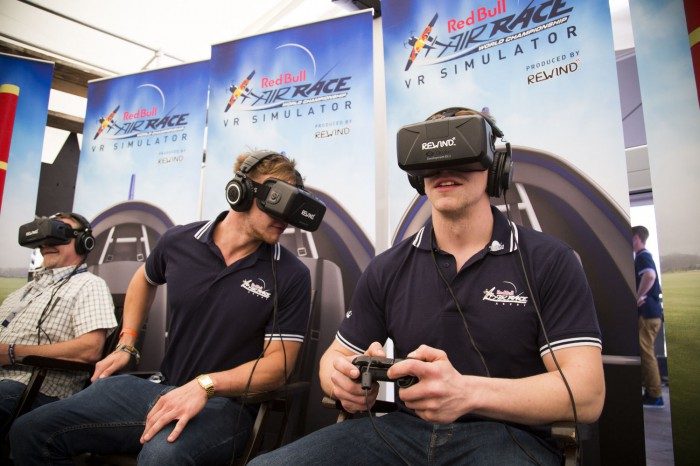Road to VR was invited to an event at Red Bull Studios London to be among the first to try the latest version of the Red Bull Air Race VR Experience with positional tracking and the Oculus Rift DK2, an experiential marketing application developed by Rewind FX. Road to VR’s Jon Tustain sits down to speak with Solomon Rogers, founder of Rewind FX, about the company’s work with virtual reality experiences.
Rewind FX are making a big name for themselves in virtual reality. My first contact with the company was when I tried the London Rift Experience—a 360 degree photography-based tour of London, using photography taken by 360 specialists Visualise.
One of the company’s most recent projects is the Red Bull Air Race VR Experience which puts players in the cockpit of the propeller driven planes used in Red Bull’s Air Race World Championship. Road to VR recently got to check out the latest versions of the experience which is updated for use with the Oculus Rift DK2 including positional tracking.
There were two versions of the experience: a passenger and interactive version, the latter being easily the most impressive as one could control the plane. You get the chance to barrel roll and race over an accurate simulation of the Royal Ascot Racecourse, of which was lidar-scanned and reconstructed in Unreal Engine 4. It was a great fusion of real world visuals and CG interactivity.
See Also: The ‘Birdly’ Experience: Earning My Wings in Virtual Reality
According to Solomon Rogers, founder of Rewind FX, Red Bull was always keen to push towards 360 video projects but Solomon was adamant that the only way you are going to give someone the experience of racing through the air at 200 mph was by building the environment entirely in CG in UE4.
The Red Bull Air Race VR Experience is not yet publicly released, but the demo station is currently touring around the UK; you can find out if it will be near you on the map on this page.
Interview Highlights
On positional tracking:
“[The Red Bull Air Race VR Experience] was great in DK1 but the DK2 changes everything. It’s not about leaning close to the dashboard or leaning back, it’s the subtleties and nuances. It’s that additional bit of movement that puts you in the plane.”
On the market for VR content:
“It’s not a consumer product so right now you are either developing for the future, such as a triple AAA game or an indie game, which is fun; maybe a few people who have DK1s or DK2s will download it, or give you one pound fifty or whatever, but the stance we are taking is brand engagement or product experiences or in some way emotional connections, can be done in the right way.
I think the other one which we have not done a lot of is narrative, for film, book experiences and tell a story; now that is hard. How are we going to tell stories in VR beyond trying to just do a linear narrative?”
On Mobile VR and the Samsung VR device:
“If you consider what you are producing is for a split-eye Android based device then you can do that now. You can with Google Cardboard or Altergaze. You can already get your hands on what you are developing for. The only thing you can’t look at is any of the other interactivity connections to it. We know there is a joypad, that connects to [Samsung Gear VR] but bluetooth joypads exists right now, so you can be developing for it already.”
“The way we look at the content we produce, the apps we produce, is the understanding that mobile VR will take over as the most adopted form, so the Oculus Rift project—big home VR headset, big gaming, home cinema type stuff—is one end, and mobilised, dock-it-in-front-of-a-headset thing, will be the one most people will take on. You got great app stores, immersive content and we can give it to people right now at a much cheaper price point. You don’t have to have a crazy powerful PC.”
On the relationship with Facebook:
“We have got a great relationship with Facebook, they saw our work, they invited us in to talk to them and there are some interesting things there.
You put the headset on, it’s a personal experience, when I play games I lock the door, I don’t want someone coming up to me and freaking me out when midway through a game but I think where the two companies are taking this, especially Facebook, and this is my personal opinion only, is they are trying to define a new form of social interaction, so they did that with social media, Facebook is the way a lot of people communicate with each other, and we had a really bad time with Second Life, but it was a really good idea, communities, ideas, places, build your own universes. I know some people who are musicians that play to gigs to thousands of people still in Second Life now, thousands of real people go to a virtualised environment to listen to someone play live.”
“I think where [Facebook] are really taking it is sports, and education, so I can sit in the front of an MIT class and be involved with it, or I can be in the best place in the house, but I think people will go to social places to engage with each other as avatars. The success of World of Warcraft still baffles me. I think where we are going with our VR world where people can communicate and enjoy experiences together in the comfort of their own home which they could not do otherwise.”




